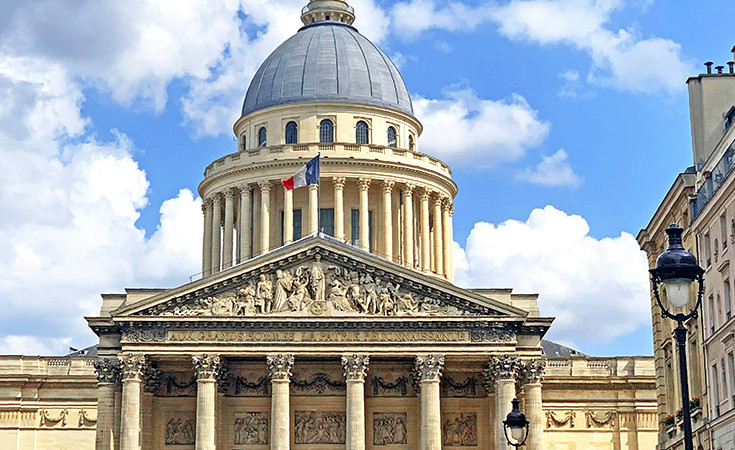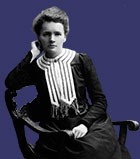
Pantheon is a colossal building that nowadays serves as a mausoleum where some of the most respected writers, scientist and politicians are buried. The beauty of Pantheon is indisputable, as the sheer size of the building, its beautiful architecture and murals that decorate the interior impress most of the visitors. Have you heard of Victor Hugo, Émile Zola, Pierre Curi and Marie Curie Alexandre Dumas? They are just some of the famous French citizens who earned they right to be buried here.
Pantheon is a mausoleum that unequivocally resembles Pantheon in Rome. This is not a coincidence since the name and the architecture outlines were borrowed from the Roman cousin. However, commissioned as a church, the main idea was to build a very large monument that could compete with size and beauty of Saint Peter’s Basilica in Rome.
In 1744, King Luis XV vowed to build a large temple instead of the Abbey of St Genevieve in Paris (as it was in deteriorating conditions) if he recovered from his illness. As he did recover, the construction of Pantheon started in 1758 and the building was only finished in 1790 due to the lack of funds. The sheer size of the church was really impressive- 110 meters long, 84 meters wide and 83 meters high.
However, the end of the construction works on the church coincided with the start of the French Revolution, therefore a year after it was completed, the main purpose of the building was changed to a mausoleum. This mausoleum was to become the final burying place of most important Frenchmen.
The Crypt of the Pantheon
Beneath the Pantheon there is a very large Crypt, where the greatest French writers, philosophers, scientist etc. are buried. Only those recognized as National Heroes by the French Parliament could be buried here. Some of the famous individuals buried in this crypt are:
Count of Mirabeau was the first person to be buried here. He was an aristocrat who found his way as one of the political leaders in the French Revolution, acquiring the reputation as the voice of the people. He was the leader of the moderate revolution arguing for the constitutional monarchy (monarch’s powers limited by the parliament). After his natural death, he became a hero of the nation. However, it was discovered he was financed by Luis XVI and the Austrians, leaving historians thorn even today whether he was a hero of the nation or a traitor.
Jean-Jacques Rousseau was buried here in 1794. He was a French philosopher, writer and composer. Some of his writings shaped the modern political and social thought, while his novel Confessions initiated modern autobiography.
Joseph-Louis Lagrange, a famous Italian-French mathematician, best known for a number of theorems called Lagrange’s theorems was also buried here.
 Victor Hugo, a famous French writer whose novels, such as: The Hunchback of Notre-Dame and Les Misérables are known around the world. One more interesting fact about Hugo is that even while he was married he enjoyed numerous other relationships, so much so that his biographers never managed to count all of his mistresses.
Victor Hugo, a famous French writer whose novels, such as: The Hunchback of Notre-Dame and Les Misérables are known around the world. One more interesting fact about Hugo is that even while he was married he enjoyed numerous other relationships, so much so that his biographers never managed to count all of his mistresses.
Émile Zola was a famous French novelist and also a political figure. His remains were moved to the Pantheon several years after his death.
 Pierre Curie and Marie Curie, a husband and wife and famous French (Marie was a naturalized Polish citizen) physicists whose pioneer work among other discoveries led to the discovery of radioactivity, plutonium and radium. Marie was the first woman to win a Nobel prize and the only woman to have won it twice. Marie is the only person to have won a Nobel Prize in two different fields of science. Curie is also a unit of radioactivity, but some controversy regards whether it was named after Pierre, Marie or both of them. Pierre and Marie were both buried in the Pantheon.
Pierre Curie and Marie Curie, a husband and wife and famous French (Marie was a naturalized Polish citizen) physicists whose pioneer work among other discoveries led to the discovery of radioactivity, plutonium and radium. Marie was the first woman to win a Nobel prize and the only woman to have won it twice. Marie is the only person to have won a Nobel Prize in two different fields of science. Curie is also a unit of radioactivity, but some controversy regards whether it was named after Pierre, Marie or both of them. Pierre and Marie were both buried in the Pantheon.
 Alexandre Dumas’ ashes were transferred to Pantheon 132 years after his death in 2002. World famous writer best known for his novels: The Count of Monte Cristo, The Three Musketeers, Twenty Years After etc. was the son of Thomas-Alexandre Dumas, a famous French Army general. Thomas was a son of a French nobleman and an enslaved African woman who achieved the highest rank in the French Army as a colored person. This is why even Alexandre Dumas was of darker skin color and why he waited so long to receive the honor of being buried at Pantheon.
Alexandre Dumas’ ashes were transferred to Pantheon 132 years after his death in 2002. World famous writer best known for his novels: The Count of Monte Cristo, The Three Musketeers, Twenty Years After etc. was the son of Thomas-Alexandre Dumas, a famous French Army general. Thomas was a son of a French nobleman and an enslaved African woman who achieved the highest rank in the French Army as a colored person. This is why even Alexandre Dumas was of darker skin color and why he waited so long to receive the honor of being buried at Pantheon.
Interesting facts